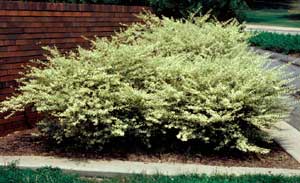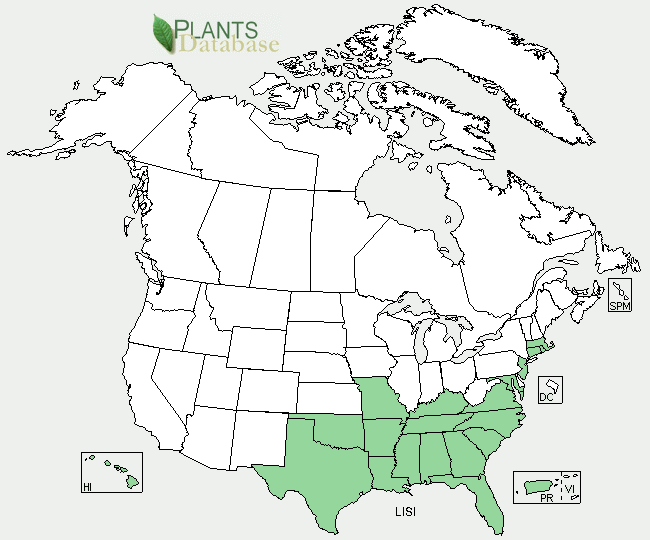[And I don’t mean “greatest hits”, I mean “Mafia hit”]
Gardeners, yardeners, and designers are on a perpetual lookout for a good hedge species. Hedges are useful in so many ways: providing backdrop for a border, making good neighbors, containing football players, etc. In reference to the latter, the field at Sanford Stadium at the University of Georgia (cue woofing!) is known as “Between the Hedges”. In the extensive lore of UGA football, everyone makes like it’s some sacred plant, but (gasp!) it’s just plain ol’ privet. Aside to Jeff, my fellow UGA alum: CNN just reported the dubious distinction that Georgia is the #1 party school in the country (again). Maybe this is why I can’t remember the Krebs Cycle.

Variegated Chinese Privet in all its shrubby glory; photo from University of Arkansas Cooperative Extension.
Back to privet. Designers of D.O.T. landscapes such as medians and interchanges seem especially enamored. Clouds of variegated privet (L. sinense ‘Variegatum’) dot interstates throughout the South. Yes, it’s tough, useful, variegated, and touted as “wildlife friendly” by some leading gardening resources. The berries are indeed good bird food; therein lies the problem. Seeds pooped out by birds results in the green, non-variegated version – much more vigorous and deposited everywhere. For the record, the variegated form also reverts like crazy.
My family’s farm in northeast Georgia is bordered by the North Fork of the Broad River. Over the years, the river bottom, and then the fence lines at all elevations, have filled with privet. It is, pardon my language, a total bitch to remove and almost impossible to eradicate. The State Botanical Garden of Georgia in Athens has an entire squad dedicated to eliminating it from acres of river bottom; ironically, only a few miles from Sanford Stadium. Thought of mostly as a Zone 7-9 plant; we have lots of it in the woods here in the mountains – an entire zone cooler.

Distribution of L. sinense; USDA PLANTS Database http://plants.usda.gov/
Ligustrum sinense is on at least two official Invasive and Noxious Weeds lists by the Southeast Exotic Pest Plant Council and Florida Exotic Pest Plant Council as well as several international lists. Nursery growers and landscapers across the South know these things. So why, why, why, do they continue to produce and spec it? “Variegated foliage sells. People see it, like it, and then ask for it. It’s a bread-and-butter item.” This comment came from the owner of a fairly large nursery that sells to independent garden centers.
Our industry yelps whenever a state or federal mandate threatens to impose restrictions on a best-seller (Hedera helix, for recent example). There are LOTS of terrific woody plants out there, people. The Dirr book is now up to 1250 pages – thumb through and pick a few alternatives. Cease and desist with the Chinese privet.
Thanks for your post, Holly… it has made me start thinking. I’m in the Pacific Northwest region (Oregon) and have recently planted Spiraea japonica ssp. It seems to re-seed itself readily. Does anybody out there know if this is a tendency toward an invasive habit? I’m beginning to wonder if it was the wisest idea to plant these… and am considering pulling them out while I’m ahead. I’ve also noticed how they’ve become very popular as of late in some of the more industrial landscapes (parking lots, etc.). This just makes me wonder if it will ever become a problem like the privet, or Hedera helix, etc. I’m not sure if it is dispersed by birds or other animals that take it beyond the original planting. If you can, let me know what you think?
Jam, I’m sure Linda can answer the Pacific NW region question; Spiraea is roaming around here in the pseudo-South, I can tell you that. The “www.invasive.org” site says the seeds are water-distributed. It is on a few east-of-the-Mississippi invasive lists. Barberry is another one that’s becoming problematic here.
I can’t speak for the Northwest, but Spirea japonica is on the Mid Atlantic invasive species list, one step down from the most invasive (which includes all privet species, even North of Va.
Spirea japonica spreads even without water distribution, if my property is any example.
From personal experience there, (30 acres, 6 ‘landscaped’ 24 forested, with uninterrupted forest to the Appalachian Trail, the only one on the list that I might not agree with is the wineberry, given that the native blackberry and black raspberry seem to have no problems competing, and wineberries taste better. IMHO, of course.
http://www.invasive.org/eastern/midatlantic/
(P.S. did you notice, Holly, that one of the sponsors of that site is UGA?)
…but of course I noticed, Ray! And was sampling invasive wineberry myself the other day – heh.
Back to UGA, The research folks at the SBGG have some terrific programs in the area of plant conservation; the Botanical Guardians program is especially good at getting volunteers involved.
For those of you who haven’t discovered the USDA’s PLANTS database website, it’s great. It lists all plants – natives, nonnatives, invasives, etc. Here’s a URL for Spiraea japonica: http://plants.usda.gov/java/profile?symbol=SPJA showing its reported distribution.
Jam, if you’re seeing reseeding of this plant, I’d report it to Oregon’s invasives species council to give them a heads up:
http://www.oregon.gov/OISC/contact_us.shtml.
Another important fact about Ligustrum sinense. It is a well known whitefly host plant. A bit of searching on the subject should be helpful, especially for the southern gardener fighting whitefly infestations on Gardenias. Very common to see both types of shrubs growing together in southern yards. Removal of the Chinese privet may help to eliminate whitefly problems.
Thanks for the helpful hints on the Spiraea, all!
Ahhh – my parents in AL have been battling this for ages on the empty parcel beside them. The current owners ( my cousins !) don’t care, even seem to think it’s a good thing to have there. Some people just can’t be convinced.
I’m always shocked when ( here in Cali) I walk into a nursery & find Scotch Broom for sale, a known invasive. A few of the counties around here have designated weeks for identifying & removing as many of the SBs as possible. Even worse, CalTrans (our DOT) seems to favor it as a highway interchange plant !
It’s really annoying that nurseries are allowed to sell privet. I’ve removed 50 mature plants from my grandmother’s yard, and it’s a pain in the ass but I’m a runner and a birder, so I see how it literally takes over areas outside suburban yards. I don’t buy that, “People see it an they want it” excuse. Well, stock plants that don’t harm wildlife. Let people *see* those plants on your shelves. It gets warm, many people want to go out and work in the yard and plant something, so they go to the nearest box garden store and buy what’s there because they don’t know where to seek out good plants or even that they should need to. The nursery people know better though. They should stock other plants, and people would buy them. I think they don’t want to admit that privet is cheap, but good grief! Enough cheap Chinese plants already!